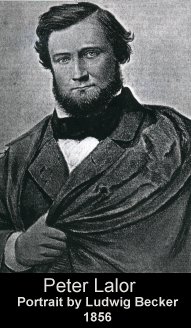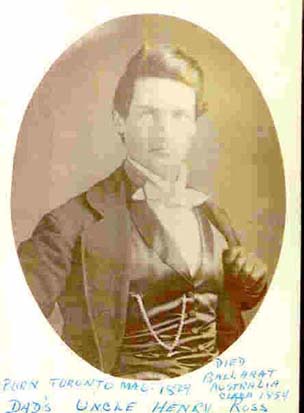Home
* Contact * INDEX *
Current Issues * Priority Issues *
Reference Index * Selwyn's
Profile * Your
Comments
.
THE
EUREKA FLAG
The Eureka Flag was a flag born out of adversity
and over 150 years later is still looked upon as a symbol of nationalism
This flag was first used by gold miners at a town
meeting held in November 1854 and subsequently flown as they came to fight for
justice in the rebellion of the Eureka Stockade at Ballarat in Victoria,
Australia.
Lead by Peter Lalor the Eureka uprising took place
on 3rd December 1854. It followed years of constant discontent on the Victorian
goldfields and has come to be regarded as a `milestone in Australian democracy'.
The Eureka flag is closely associated with this struggle for democracy.

THE OATH OF THE EUREKA FLAG
The miners in Peter Lalor's patrol were all sworn
in by him before the ‘Battle of the Eureka Stockade’.
'It is my duty now to swear you
in and to take with you the oath to be faithful to the Southern Cross. Hear me
with attention. The man who, after this solemn oath, does not stand by our
Standard is a coward in heart. I order all persons who do not intend to take the
oath to leave at once.'
'We swear by the
Southern Cross to stand truly by each other and fight to defend our rights and
liberties.'
THE ATTACK
A government force consisting of detachments of
British Regiments, the 12th and 40th, plus mounted and foot police of the
Victoria Police, attacked an entrenchment of aggrieved gold miners at Ballarat
at daybreak on 3rd December 1854. The resulting action, the attack on the Eureka
Stockade, is today among Australia's greatest legends.
For two days earlier the gold-miners in revolt
seemed to hold the future of Victoria in their grasp. A well-armed group of
'Californian’s' and Canadians were among parties of 'foreign anarchists' set
upon achieving Parliamentary democracy…and nothing less.
But the Irish seemed to predominate, and English
Chartists, Scots, Swedes, at least two Italians, a Jamaican, and an
African-American said to be from Baltimore, Maryland, were involved in the
uprising. The Ballarat Reform League gave some semblance of organisation to
these strands of indignation about gold licensing fees, a desire for political
reform, and the general disorder at Ballarat.
To complicate matters, a further force of 800
troops, including a Naval Brigade from HMS Fantome and HMS Electra, with
howitzers and shrapnel ammunition, was on its way from Melbourne.
Gold Commissioner Robert Rede (who later
officiated as Sheriff during the 1880 hanging of bushranger Ned Kelly) decided
to strike quickly without waiting for the large reinforcement from Melbourne.
Captain J. W. Thomas (40th Regt) and a scout led
the combined government force to the Stockade in the early hours of 3 December.
The Stockade was all but deserted; few miners believing it would be attacked on
the Sabbath. The Stockade was thus taken with minimal casualties, but these
increased when mounted police attacked bystanders.
Of some 120 men captured at the Stockade, only 13
were committed for trial. The State Treason Trials commenced in February 1855.
Successive Melbourne juries refused to convict any of the defendants. Democratic
reforms ensued, with peace being eventually restored on Victoria's goldfields.

Charles Doudiet's (recently discovered)
contemporary sketch captures the moment when the Eureka Hotel was torched by a
mob on the 17th October 1854. Many historians believe this was the
catalyst for the Eureka Rebellion. This sketch is currently in the collection of
the Ballarat Fine Art Gallery.
Research in the 1990s has led to many interesting
discoveries about the Stockade, and circumstances leading up to the attack.
Included among these are the Charles Doudiet watercolour sketches, purchased at
auction in 1996 by the Ballarat Fine Art Gallery (home of the original Eureka
Flag). Doudiet, a Canadian miner, was apparently at the Stockade. He helped
carry away the fatally wounded Canadian leader, 'Captain' Henry (according to
letters and information supplied by a Canadian source) Ross.
Other than a watercolour by J. B. Henderson,
showing the attack, and supposed to be contemporary, the Doudiet sketches may
provide the only genuine images of Eureka available today.
'Captain' Henry (or Charles, according to official
documents in Victoria, Australia) Ross is believed to have been the designer of
the famous Eureka Flag. It has been suggested that his flag design might have
been influenced by the flag of Quebec, Canada.
The Eureka Flag was also described as The Southern
Cross and is thought to resemble that constellation. The flag has been used
since by both sides of Australian politics for various purposes.

|
Captain Henry
Ross, the Canadian leader at the Eureka Stockade. Known as Charles Ross
in Australian documents, such as his death certificate, Ross was shot 10
or 15 minutes after being arrested.
Photograph by
S. J. Dixon, of the Electric Light Photo Galleries, Toronto, Canada and
provided by a proud relative in Canada. |
Interestingly, only two people, one killed, the
other captured at the Stockade, were Australian
born. Both were from New South Wales. That colony (now State) was also the scene
in 1804, of Australia's first serious armed uprising (of Irish convicts) at
Vinegar Hill near Parramatta.
The password at the Eureka Stockade on the night
of 2-3 December 1854 was... 'Vinegar Hill'.
Click here for: PAGE
INDEX
RETURN TO:
AUSTRALIAN
FLAGS
![]()
![]()








